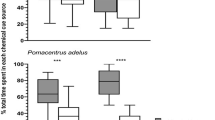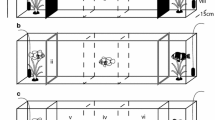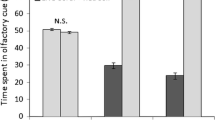Abstract
One of the great mysteries of coral-reef fish ecology is how larvae locate the relatively rare patches of coral-reef habitat on which they settle. The present study aimed to estimate, by experiments in aquaria, the sensory modalities of coral-reef fish larvae for senses used in searching for their species’ settlement habitat. Larval recognition of settlement habitat can be based on the detection of conspecifics and/or of characteristics of coral habitat using visual, chemical and mechanical cues. For this study, larvae were captured with crest nets and were then introduced into experimental tanks that allowed testing of each type of cue separately (visual, chemical or mechanical cues). Among the 18 species studied, 13 chose their settlement habitat due to the presence of conspecifics and not based on the characteristics of coral habitat, and 5 species did not move toward their settlement habitat (e.g. Scorpaenodes parvipinnis, Apogon novemfasciatus). Among the different sensory cues tested, two species used the three types of cues (Parupeneus barberinus and Ctenochaetus striatus: visual, chemical and mechanical cues), six used two types (e.g. Myripristis pralinia: visual and chemical cues; Naso unicornis: visual and mechanical cues), and five used one type (e.g. Chrysiptera leucopoma: visual cues; Pomacentrus pavo: chemical cues). These results demonstrate that many coral-reef fish larvae could in practice use sensory cues for effective habitat selection at settlement, and have the ability to discriminate species-specific sensory cues.

Similar content being viewed by others
References
Baker CF, Montgomery JC (2001) Species specific attraction of migratory banded kokopu juveniles to adult pheromones. J Fish Biol 58:1221–1229
Booth DJ (1992) Larval settlement patterns and preferences by domino damselfish Dascyllus albisella Gill. J Exp Mar Biol Ecol 155:85–104
Booth DJ (2002) Distribution changes after settlement in six species of damselfish (Pomacentridae) in One Tree Island lagoon, Great Barrier Reef. Mar Ecol Prog Ser 226:157–164
Brown GE, Godin JJ (1997) Antipredator responses to conspecific and heterospecific skin extracts by threespine sticklebacks: alarm pheromones revisited. Behaviour 134:1123–1134
Brown JH, Kodric-Brown A (1977) Turnover rates in island biogeography: effect of immigration on extinction. Ecology 58:445–449
Browne KA, Zimmer R (2001) Controlled field release of a waterborne chemical signal stimulates planktonic larvae to settle. Biol Bull 200:87–91
Cassier P, Bohatier J, Descoins C, Nagnan Le Meillour P (2000) Communication chimique et environnement. Belin, Paris
Cato DH (1992) The biological contribution to the ambient noise in waters near Australia. Acoust Aust 20:76–80
Doherty PJ (2002) Variable replenishment and the dynamics of reef fish populations. In: Sale PF (ed) Coral reef fishes: dynamics and diversity in a complex ecosystem. Academic, San Diego, pp 327–358
Doherty PJ, Dufour V, Galzin R, Hixon MA, Planes S (2004) High mortality at settlement is a population bottleneck for a tropical surgeonfish. Ecology (in press)
Dudley B, Tolimieri N, Montgomery J (2000) Swimming ability of the larvae of some reef fishes from New Zealand waters. Mar Freshwater Res 51:783–787
Dufour V, Galzin R (1993) Colonisation patterns of reef fish larvae to the lagoon at Moorea Island, French Polynesia. Mar Ecol Prog Ser 102:143–152
Elliott JK, Elliott JM, Mariscal RN (1995) Host selection, location, and association behaviors of anemone fishes in field settlement experiments. Mar Biol 122:377–389
Fontaine M, JeanJean S, Monzikoff A (1982) Intervention possible de la riboflavine (vitamine B2) comme télémédiateur chimique dans les écosystèmes aquatiques. C R Acad Sci Sér III:165–167
Gebauer P, Walter I, Anger K (1998) Effects of substratum and conspecific adults on the metamorphosis of Chasmagnathus granulata (Decapoda) megalopae. J Exp Mar Biol Ecol 223:185–198
Gebauer P, Paschke K, Anger K (2002) Metamorphosis in a semiterrestrial crab, Sesarma curacaoense: intra and interspecific settlement cues from adults odors. J Exp Mar Biol Ecol 268:1–12
Giese AC, Pearse JS, Pearse VB (1991) Reproduction of marine invertebrates. Boxwood, Calif
Hanski I (1999) Metapopulation ecology. Oxford University Press, Oxford
Hanski I, Gilpin ME (1997) Metapopulation biology: ecology, genetics and evolution. Academic, San Diego
Hansson L (1991) Dispersal and connectivity in metapopulations. Biol J Linn Soc 42:89–103
Harvey AW (1996) Delayed metamorphosis in Florida hermit crabs: multiple cues and constraints (Crustacea: Decapoda: Paguridae and Diogenidae). Mar Ecol Prog Ser 141:27–36
Hellstrom T, Doving KB (1986) Chemoreception of taurocholate in anosmic and sham-operated cod, Gadus morhua. Behav Brain Res 21:155–162
Holbrook SL, Brooks AJ, Schmitt RJ (2002) Predictability of fish assemblages on coral patch reefs. Mar Freshwater Res 53:181–188
Holm S (1979) A simple sequentially rejective multiple test procedure. Scand J Stat 6:65–70
Katzir G (1981) Aggression by the damselfish Dascyllus aruanus L. towards conspecifics and heterospecifics. Anim Behav 29:835–841
Kingsford MJ, Leis JM, Shanks A, Lindeman K, Morgan S, Pineda J (2002) Sensory environments, larval abilities and local self-recruitment. Bull Mar Sci 70:309–340
Lecchini D (2003) Identification of habitat use strategies between the colonisation and recruitment stages of coral reef fish in the lagoon of Moorea (French Polynesia): approach by behavioural ecology. PhD Thesis, Ecole Pratique des Hautes Etudes and University of Pierre and Marie Curie
Leis JM, Carson-Ewart BM (1997) In situ swimming speeds of the late pelagic larvae of some Indo-Pacific coral reef fishes. Mar Ecol Prog Ser 159:165–174
Leis JM, Carson-Ewart BM (1999) In situ swimming and settlement behaviour of larvae of an Indo-Pacific coral reef fish, the coral trout Plectropomus leopardus (Serranidae). Mar Biol 134:51–64
Leis JM, Carson-Ewart BM, Cato DH (2002) Sound detection in situ by the larvae of a coral reef damselfish (Pomacentridae). Mar Ecol Prog Ser 232:259–268
Mercier A, Battaglene SC, Hamel JF (2000) Settlement preferences and early migration of the tropical sea cucumber Holothuria scabra. J Exp Mar Biol Ecol 249:89–110
Milicich MJ (1994) Dynamic coupling of coral reef fish replenishment and oceanographic processes. Mar Ecol Prog Ser 110:135–144
Miyagawa K (1989) Experimental analysis of the symbiosis between anemonefishes and sea anemones. Ethology 80:19–46
Myrberg AA, Fuiman LA (2002) The sensory world of coral reef fishes. In: Sale PF (ed) Coral reef fishes: dynamics and diversity in a complex ecosystem. Academic, San Diego, pp 123–148
O’Connor NJ, Judge ML (1997) Flexibility in timing of molting of fildler crab megalopae: evidence from in situ manipulation of cues. Mar Ecol Prog Ser 146:55–60
Ohman MC, Munday PL, Jones GP, Caley MJ (1998) Settlement strategies and distribution patterns of coral reef fishes. J Exp Mar Biol Ecol 225:219–238
Sale PF (1978) Coexistence of coral reef fishes a lottery for living space. Environ Biol Fish 3:85–102
Sale PF, Douglas WA (1984) Temporal variability in the community structure of fish on coral patch reefs and the relation of community structure to reef structure. Ecology 65:409–422
Schmitt RJ, Holbrook SJ (1985) Patch selection by juvenile black surfperch under variable risk: interactive influence of food quality and structural complexity. Mar Freshwater Res 11:12–21
Sola C, Tosi L (1993) Bile salts and taurine as chemical stimuli for glass eels, Anguilla anguilla: a behavioural study. Environ Biol Fish 37:197–204
Steele MA, Forrester GE (2002) Early postsettlement predation on three reef fishes: effects on spatial patterns of recruitment. Ecology 83:1076–1091
Stobutzki IC, Bellwood DR (1997) Sustained swimming abilities of the late pelagic stages of coral reef fishes. Mar Ecol Prog Ser 149:35–41
Sweatman HPA (1988) Field evidence that settling coral reef fish larvae detect resident fishes using dissolved chemical cues. J Exp Mar Biol Ecol 124:163–174
Tolimieri N, Jeffs A, Montgomery JC (2000) Ambient sound as a cue for navigation by the pelagic larvae of reef fishes. Mar Ecol Prog Ser 207:219–224
Turchin P (1996) Fractal analyses of animal movement: a critique. Ecology 77:2086–2090
Victor BC (1991) Settlement strategies and biogeography of reef fishes In: Sale PF (ed) The ecology of fishes on coral reefs. Academic, San Diego, pp 231–260
Weins JA (2001) The landscape context of dispersal. In: Clobert J, Danchin E, Dhondt AA, Nichols JD (eds) Dispersal. Oxford University Press, New York, pp 96–109
Weins JA, Stenseth NC, Van Horne B, Ins RA (1995) Ecological mechanisms and landscape ecology. Oikos 66:369–380
Westcott DA, Graham DL (2000) Patterns of movement and seed dispersal of a tropical frugivore. Oecologia 122:249–257
Wootton RJ (1991) Ecology of teleost fishes. Chapman & Hall, Paris
Yamamoto H, Shimizu K, Tachibana A, Fusetani N (1999) Roles of dopamine and serotonin in larval attachment of the barnacle, Balanus amphitrite. J Exp Zool 284:746–758
Acknowledgements
The authors wish to thank Christiane and Douchka Rivière for their assistance in the field. We thank J.T. Williams (Smithsonian Institution, Washington) for improving the English readability of the manuscript. This research was supported by the Ecole Pratique des Hautes Etudes (UMR 8046 CNRS-EPHE), and a Lavoisier Fellowship (French Ministry of Foreign Affairs) awarded to D. Lecchini. Additional logistic and financial support was provided by the Centre de Recherches Insulaires et Observatoire de l’Environnement (CRIOBE). The authors have adhered to the Guidelines for the Use of Animals in Research.
Author information
Authors and Affiliations
Corresponding author
Additional information
Communicated by J. Krause
Rights and permissions
About this article
Cite this article
Lecchini, D., Planes, S. & Galzin, R. Experimental assessment of sensory modalities of coral-reef fish larvae in the recognition of their settlement habitat. Behav Ecol Sociobiol 58, 18–26 (2005). https://doi.org/10.1007/s00265-004-0905-3
Received:
Revised:
Accepted:
Published:
Issue Date:
DOI: https://doi.org/10.1007/s00265-004-0905-3




